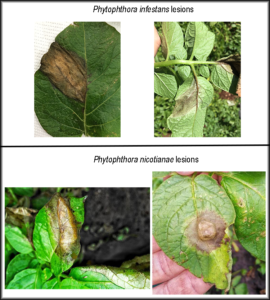Phytophthora nicotianae causing severe disease on Potato and Tomato in N.C.
go.ncsu.edu/readext?531594
en Español / em Português
El inglés es el idioma de control de esta página. En la medida en que haya algún conflicto entre la traducción al inglés y la traducción, el inglés prevalece.
Al hacer clic en el enlace de traducción se activa un servicio de traducción gratuito para convertir la página al español. Al igual que con cualquier traducción por Internet, la conversión no es sensible al contexto y puede que no traduzca el texto en su significado original. NC State Extension no garantiza la exactitud del texto traducido. Por favor, tenga en cuenta que algunas aplicaciones y/o servicios pueden no funcionar como se espera cuando se traducen.
Português
Inglês é o idioma de controle desta página. Na medida que haja algum conflito entre o texto original em Inglês e a tradução, o Inglês prevalece.
Ao clicar no link de tradução, um serviço gratuito de tradução será ativado para converter a página para o Português. Como em qualquer tradução pela internet, a conversão não é sensivel ao contexto e pode não ocorrer a tradução para o significado orginal. O serviço de Extensão da Carolina do Norte (NC State Extension) não garante a exatidão do texto traduzido. Por favor, observe que algumas funções ou serviços podem não funcionar como esperado após a tradução.
English
English is the controlling language of this page. To the extent there is any conflict between the English text and the translation, English controls.
Clicking on the translation link activates a free translation service to convert the page to Spanish. As with any Internet translation, the conversion is not context-sensitive and may not translate the text to its original meaning. NC State Extension does not guarantee the accuracy of the translated text. Please note that some applications and/or services may not function as expected when translated.
Collapse ▲
Fig. 1 Comparison of foliar lesions of Phytophthora infestans and Phytophthora nicotianae. Note the whitish halo on the rightmost image of P. infestans.
Due to the recent run of warm, wet weather, conditions are ideal for the development of late blight (Phytophthora infestans) on potato and tomato crops. Over the past two weeks we have received samples exhibiting late blight-like symptoms on tomato and potato. However, further evaluation of these samples has shown that these infections on both tomato and potato were caused by a related species, Phytophthora nicotianae. While normally a soil-borne pathogen, the presence of foliar lesions indicates that the pathogen is also spreading aerially. In eastern NC severe foliar infections have been observed. The severe wet weather and high temperatures are highly favorable for the pathogen, unlike P, infestans, that is most severe under cool weather conditions.
P. nicotianae has been detected on both potato and tomato crops. P. nicotianae differs from P. infestans in several ways. While both pathogens can infect foliage and tubers, P. nicotianae is primarily a soilborne pathogen and can infect plant roots. It also has a broader host range than P. infestans and the ability to generate overwintering survival spores including oospores and chlamydospores in soil (Table 1). Foliar infections of P. nicotianae resemble symptoms associated with late blight, including large, water-soaked lesions on leaves and stems (Fig 1). This year, foliar blight has been severe on potato and tuber rot has also occurred. However, P. nicotianae lesions generally do not exhibit sporulation. Due to the tendency of P. infestans to sporulate heavily, lesions caused by P. infestans may show a whitish halo on the underside of the leaf where spores can be observed under a hand lens, but this is not present in all infections.
Table 1: Important differences between P. infestans and P. nicotianae
| P. infestans (late blight) | P. nicotianae | |
| Mefenoxam sensitivity | Dominant lineage US-23 (sensitive to mefenoxam) | Mefenoxam resistance reported |
| Disease cycle | No soilborne phase | Soilborne oospores and chlamydospores |
| Mating types | A1 (US-23) dominant | A1 and A2 common |
| Oospores (sexual overwintering structures) | None currently reported in US | Present |
| Symptoms |
Potato: Tubers, stems, and foliage Tomato: stems, foliage and fruit |
All parts of plant including roots |
| Asexual survival stages | None | Clamydospores (asexual overwintering structures) |
| Host range | Narrow- potato and tomato | Wide- potato, tomato, citrus, tobacco, ornamentals |
Potato and tomato crops with late blight-like lesions should be carefully checked due to the presence of P. nicotianae in the state. Samples may be submitted to your local extension agent or crop consultant for further analysis or the Plant Disease and Insect Clinic at NC State. P. nicotianae does not spread as rapidly as P. infestans across fields due to lower production of sporangia, but adopting a late blight spray program following label recommendations will help manage the pathogen. Consult the control recommendations on the late blight fact sheet or the 2018 Southeastern US Vegetable Crop Handbook for more information on recommended compounds and spray schedules.
It is highly encouraged that samples that are suspected to be late blight are submitted for genotyping by following instructions on the USABlight website. The disease alert and surveillance system also includes additional information on control methods and a decision support tool for fungicide spraying. You can also register to receive email/text alerts when new late blight is reported near you.
This article was written by Amanda Saville and Dr. Jean Ristaino and edited by Inga Meadows.


